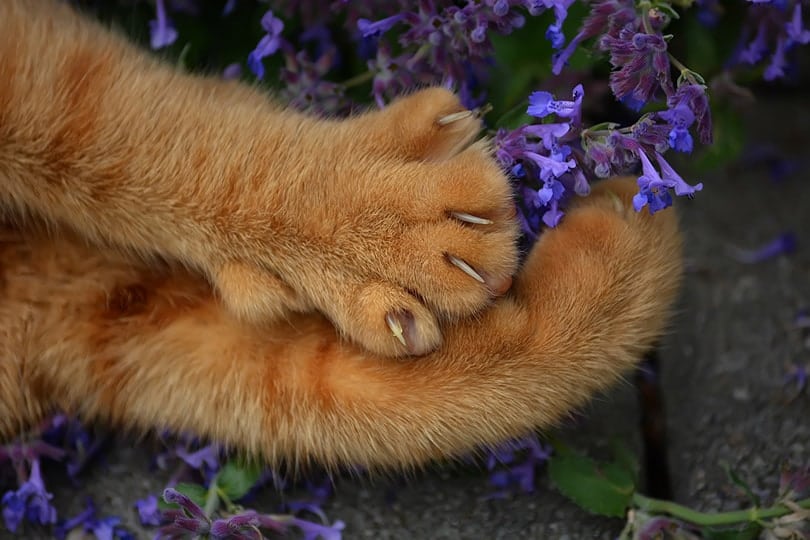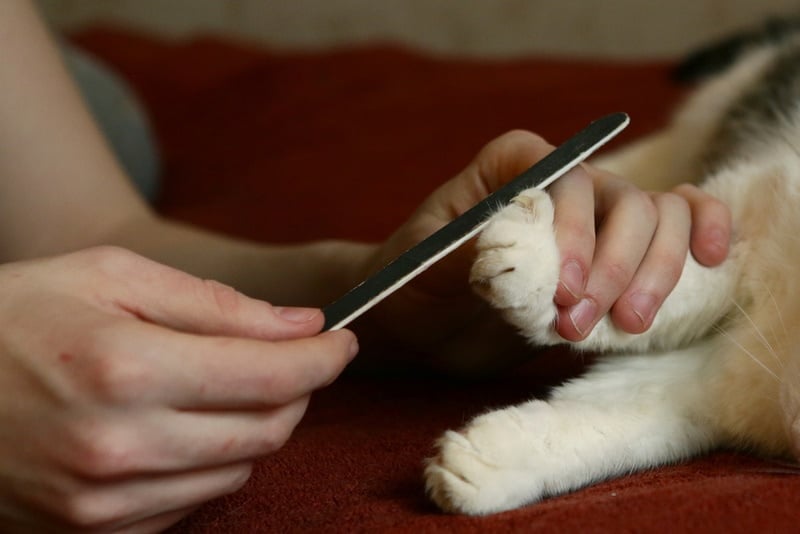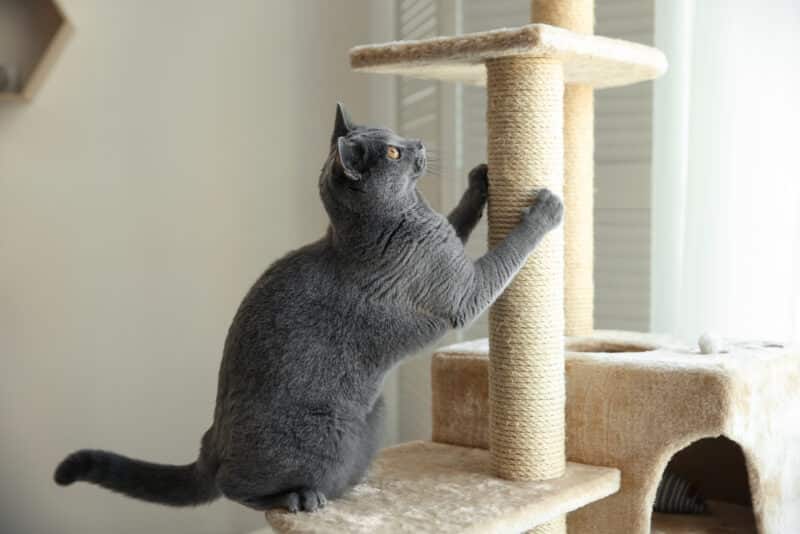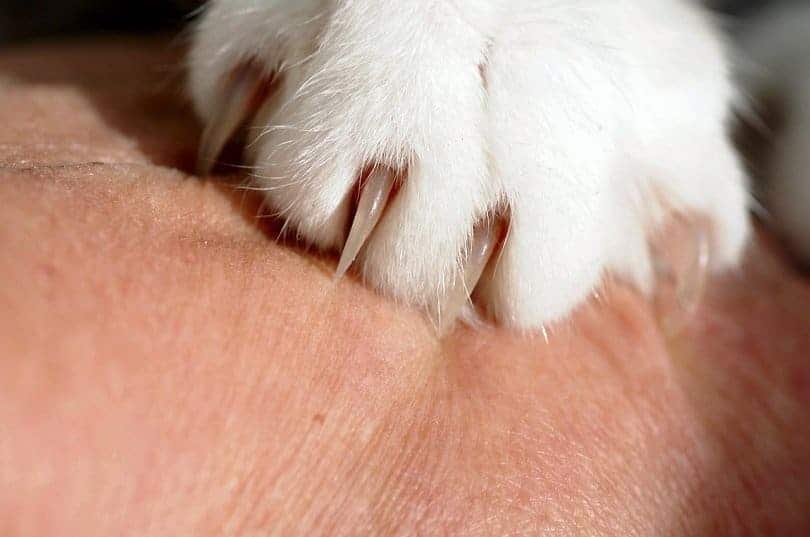The post Cat Pedicures: What’s Involved? Vet-Approved Facts & Explanation by Ashley Bates appeared first on Catster. Copying over entire articles infringes on copyright laws. You may not be aware of it, but all of these articles were assigned, contracted and paid for, so they aren't considered public domain. However, we appreciate that you like the article and would love it if you continued sharing just the first paragraph of an article, then linking out to the rest of the piece on Catster.com.
Click to Skip Ahead
Our kitties might need a little extra love in the nail department. These lethal murder mittens can do quite a lot of damage. If you’ve shared your home with a feline, you know just how much it can impact your belongings—and yourself! Too long claws can also cause pain and other issues for your cat.
So, in terms of pet pampering, what’s a pedicure like for cats? Does a cat pedicure involve the same things it does for humans? Or is it just a process where the claws become duller and less equipped for damage? Let’s find out what a cat pedicure entails!

Overview of a Cat’s Nails
If you closely examine your cat’s claws, you will notice that the tip is translucent, and the “quick” portion is visible as you look down the nail toward the toe.
The nail is a translucent portion that is the upper 1/3 of the claws, roughly. The quick is the darker or pink portion of the nail—which contains blood vessels and nerves. That is why it will bleed vigorously at the quick if you clip too far down.
It is crucial that you have solid knowledge of where the quick ends—especially if there is trimming involved.
What Do Cat Claws Do?
Cat claws are an incredibly important feature anatomically. They serve many purposes that benefit your cat’s everyday living.
- Climbing
- Scratching
- Balance
- Walking
- Digging
- Covering waste
So, you can see how they play a major role.

What Is a Pedicure for Cats?
You might be imagining your cat sitting upright with their feet in a soak tub and head wrapped up in a towel, wearing their best bathrobe. But of course, this isn’t the case.
A pedicure (or manicure) for cats is simply a fancy nail trim. Some people choose or need to trim their cat’s claws regularly, while others let this go untended. If you take your cat to the groomer, the nails are likely an area on the body that will get attention.
How Are Pedicures on Cats Performed?
A pedicure for cats is carried out carefully by trained professionals. It’s all part of the grooming process! The groomer (or groomers) will make your cat comfortable before trimming so it alarms them as little as possible.
With luck, the groomer can snip, snip, snip—and be done. For more rambunctious cats, the process might take a little longer.
Who Gives Cats Pedicures?
Professional groomers are usually the ones responsible for giving cats pedicures. However, you can perform a basic nail trim at home if you learn what to do and how to do it correctly. If you plan to do it yourself, have a helper, and be sure to ask your vet or a professional groomer to show you how.

Benefits of Pedicures for Cats
If you have a young, active kitty, and they have plenty of scratching posts, they may not need regular pedicures. However, senior and less active cats, especially those with issues like arthritis, will need regular nail trims to help keep their claws in tip top health.
If your cat’s nails get too long they may get caught on carpets and blankets. They can also start to curve and grow round into their paw pads causing a lot of pain for your cat. Of course pedicures mean your cat’s nails are less sharp as well so they do less damage around the home and if they accidentally catch you during an intense play session!
Downfalls of Pedicures for Cats
Just like any upside, there will be some cons to consider. First, pedicures can be very stressful for your cat. You might be counting down the minutes until you can relax by getting your toes and nails done. However, cats will not feel the same way.
After a few trips, your cat can acclimate (like going to the vet) and it’s always best to get them used to having their paws handled from a young age. However, cat pedicures can be very tough to handle, as an unfamiliar person is touching a sensitive part of the cat’s body. Plus, what cat actually likes being restrained and staying still?

Can You Give Your Cat a Pedicure at Home?
If you feel confident enough to accomplish the task, you can freely give your cat a pedi from the comfort of your own home. In fact, some anxious or uncomfortable felines might prefer your skills over a trained professional based on comfort alone.
First, you should get your cat a suitable sized, pet-specific type of nail clippers. Pet nail clippers are designed to put pressure on all parts of the nail, creating a clean cut.
Before you even start the trim, have a person help to gently restrain your kitty so they don’t hurt themselves or you—especially if it’s your first time.
Is Nail Trimming Really Necessary?
Your cats can file their nails naturally. In the wild a cat would wear down their nails by running, hunting, climbing and scratching. Scratching might be an easily overlooked part of cat behavior, but it’s one that is so instinctual for them. They require scratching for nail sharpening, shedding, and muscle-building. Cats also scent mark when they scratch. Indoor and older cats are more likely to have longer claws and require nail trimming.
On average, it’s recommended to check your cat’s nails once every 2 to 3 weeks and trim them if necessary.
But there are also other ways to help keep your cat’s nails as healthy as possible, as well as protecting your home from cat claws!

How to Protect Homes from Cat Claws
Protecting your home means giving your cat appropriate outlets for their natural scratching behavior, as well as keeping their nails in good shape.
1. Proper Scratching Materials
Purchasing scratching materials is an essential part of being a cat owner. It is part of your cat’s natural instinct to scratch and claw at materials.
Some cats want to claw more than others, so if you have a multi-cat household, make sure to offer a variety of materials to keep them happy. The most common materials on the market include sisal rope, sisal fabric, cardboard, and carpet.
Each one has its benefits, and you might find that your cat prefers one to the other. Some cats like vertical scratching posts and others prefer horizontal.

2. Pheromone sprays
Using pheromone sprays can encourage your cat to use a scratching post rather than furniture and carpets.
3. Keep Them Active
The more your cat plays and runs, the more likely they are to stay in shape and naturally wear down the tips of their claws without the need for such regular nail trims. If your cat is older and struggling with mobility, consult with your vet for advice.
4. Claw Covers
Claw covers are available, these are lightweight caps which are glued over your cat’s claws and are used as a way to stop your cat scratching furniture. Although a much more humane option than declawing, they are not without issues. They can be difficult to apply properly, often don’t stay in place and require regular monitoring and reapplication every 4-6 weeks. Many cats do not like them, meaning they cause stress and anxiety. Some can prevent a cat from retracting their nails properly and they can cause damage to the nail if left on for too long. They should never be used in cats that go outside and we recommend speaking to your vet if you are considering them to make sure they are a good choice for your cat.

Should You Declaw Your Cat?
Declawing is still a huge debate. Even throughout the 1990s, this practice was pretty commonplace in the US. In many other countries declawing is either banned or considered unethical. It’s a surgical process by which the claw is removed by amputating the last bone of each toe on a cat’s paw. While this might seem like a sensible solution to the problem, it’s actually very damaging for several reasons.
Declawing is an incredibly invasive procedure. It is comparable to you getting your fingers cut off at the last knuckles. This surgery is unnecessary, costly, and, many would argue, inhumane.
First, your cat’s natural instinct is to claw. When you remove the claws, they will still want to need or scratch, but they will be unable to do so. This couldn’t cause some confusion and might even make your cat unhappy.
Declawing can be painful years after the surgery is complete. Unfortunately, studies have revealed that a large percentage of declawed cats experience some level of pain intermittently or constantly and this can affect their behavior with increased incidence of aggression and inappropriate elimination.
Many vets will no longer perform this surgery as an elective procedure and the American Veterinary Medical Association discourages the elective declawing of cats and encourages the use of alternatives.


Conclusion
So, now you know exactly how to give your cat a pedicure—or what it means if a groomer does it. What do you think? Does it sound like a good plan to totally pamper your kitty on the next trip to the groomer, or will you leave the murder mittens alone?
Featured Image Credit: 135pixels, Shutterstock
The post Cat Pedicures: What’s Involved? Vet-Approved Facts & Explanation by Ashley Bates appeared first on Catster. Copying over entire articles infringes on copyright laws. You may not be aware of it, but all of these articles were assigned, contracted and paid for, so they aren't considered public domain. However, we appreciate that you like the article and would love it if you continued sharing just the first paragraph of an article, then linking out to the rest of the piece on Catster.com.
from Catster https://ift.tt/j5hq08T

